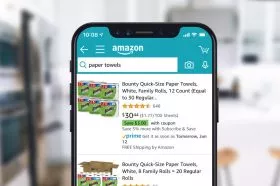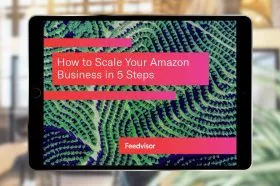Resources - Blog
How to Scale to a $20M Business [Webinar Recap]

Stay on top of the latest e-commerce and marketplace trends.
While there certainly are a number of incentives and advantages to selling on Amazon, the marketplace is an increasingly saturated and competitive arena. As such, oftentimes after launching their Amazon businesses, many sellers find themselves at a standstill, struggling to scale their operations beyond their initial growth.
However, with the proper technology, teams, resources, and strategies in place, Amazon sellers have a tremendous ability to scale to meet and keep up with demand, and position their business for sustainable growth. According to Feedvisor data, 70% of sellers grew their revenue on Amazon over the past year and 56% of sellers experienced profit growth.
In this webinar, led by former Amazonian Parag Mamnani, founder and CEO of Webgility — a multichannel management software for automating e-commerce operations — Mamnani encourages Amazon sellers to think beyond a step-by-step approach to growth and instead consider broader, high-level business strategies you can employ to increase profit margins, identify unique advantages over the competition, and ultimately scale your Amazon operation beyond the $20-million-dollar threshold.
Dissect Your Database
To begin, Mamnani outlines the importance of building a recurring business to retain customers and nurture them toward repeat purchases. Regardless of your product category — whether it be vacuum bags, cosmetics, cleaning supplies, or socks — building a recurring business can be an incredibly powerful way to scaling your operation by maximizing the customer lifetime value and reducing your customer acquisition costs (CAC).
Indeed, it is much easier and cost-efficient to sell to existing customers than it is to acquire new customers. Look at your product catalog to determine items that have the ability to resell and make sure that reordering is made as easy as possible for the customer. To achieve this, Mamnani explains, you must nurture your customers as you approach a certain timeframe. If you are selling Christmas supplies, for example, you should have a marketing strategy in place that will engage your database as the holiday season approaches to inspire a reorder.
When nurturing your customer database, Mamnani advises dissecting your data across demographic variables to determine who your buyers are and how they can be categorized into customer segments, such as religious groups or sports enthusiasts, to determine the most effective targeted campaigns for each segment. This applies to not only email campaigns but also your catalog development in terms of positioning your product catalog to be relatable to specific customer segments. The more targeted your strategy, the more focused your messaging will be, which will ultimately lead to higher conversion rates and sales growth.
Differentiate Your Brand
Given the continuous influx of competition on Amazon, differentiation is essential to scaling your business. Certainly, there are a number of ways to differentiate against the competition, but one approach Mamnani shares is by finding, what he calls, “the white space” — a unique aspect or twist to a common product in a saturated category.
By using an uncommon material for sneakers, for example, you are not only differentiating your product in a crowded market but you are also reducing your competition and can leverage your pricing and marketing strategies as such, since there is less on the marketplace that you can directly compare to. One way to identify white space, Mamnani says, is by examining customer feedback on both your own and your competitors’ reviews to consider problems you can solve or needs you can fill for the customer.
In addition, Mamnani warns that short-term ideas might be enticing for quick profit, but to create a sustainable business that can grow to the $20-million-dollar mark, you must think long-term and identify a higher purpose, or brand story, that will resonate with your customers. Doing so will help create a loyal community that fuels your business’ growth through repeat purchases as well as new customer acquisition via word of mouth.
Indeed, word of mouth is one of the most significant factors consumers consider on their path to purchase, particularly in the e-commerce space. Simple tactics like referral discounts or social media shares to receive a coupon are effective ways to expand your reach and retain existing customers, but you should also integrate your brand story into that messaging and relate it to consumers’ values to increase brand awareness.
Rethink Your Product Catalog
One aspect that Mamnani says he encounters often with Amazon sellers is the inability to grow their bottom line despite their growth in revenue. In this case, he advises cutting your low-profit products that are incurring unnecessary costs in perhaps storage or bulky fulfillment and instead focusing your time and money on high-profit products that are worth allocating more resources into to drive new customer acquisition and profitability.
Once you’ve vetted your catalog and have determined the products that are most profitable, you should focus on scaling that catalog and creating adjacent markets and campaigns that you can leverage to grow your revenue. While Amazon might be contributing to most of your revenue, diversifying to different channels will allow you to reach new customer segments that you might not be reaching on Amazon.
As you expand your product catalog and diversify channels, Mamnani emphasizes the obvious but critical factor of managing your stock to prevent overselling, which is oftentimes a major driver of poor customer reviews. Consider what inventory you have across different channels as well as what it costs to store particular products, and leverage different distribution and fulfillment channels, such as drop shipping or Fulfillment by Amazon (FBA).
Lastly, and perhaps most critically, leveraging automation is essential as you scale your business, as automation tools will free up your time to focus on high-level strategies as well as reduce the number of staff you’ll need to employ, which ultimately frees up finances to be applied to new initiatives.
Final Thoughts
While every business is different, and there are a number of factors that can impact your success on Amazon Marketplace, one thing that’s certain is that selling on Amazon requires extensive bandwidth and investment for long-term success. By employing these broad, high-level strategies and utilizing the resources and tools that are available to you, you can successfully scale your business for sustainable growth and ultimately break the $20-million-dollar threshold.
Learn what Feedvisor can do for your business.
When you partner with Feedvisor, you automatically receive access to our true, AI-driven technology and hands-on team of e-commerce experts. Contact one of our team members today to learn more about our end-to-end solution for brands and large sellers on Amazon, Walmart, and e-marketplaces.




